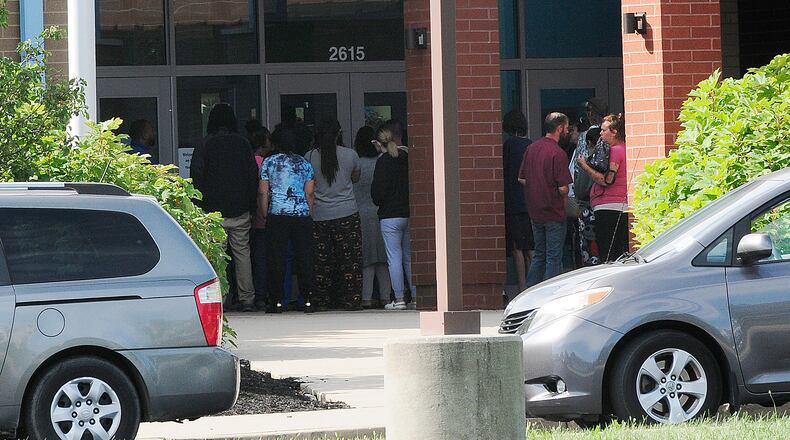Last Friday saw eight schools in Dayton, Springfield and Cincinnati areas — and more elsewhere in Ohio — targeted for fake calls of armed attackers shooting up schools, prompting local police and SWAT teams to race to school campuses. Other schools nationwide also were hit with the bogus phone calls.
The illegal practice, dubbed “swatting,” is a growing concern and now has prompted some state legislators to act with a proposed bill greatly increasing punishment for offenders.
State Rep. Kevin Miller, R-Newark, and state Sen. Andrew Brenner, R-Delaware, introduced companion bills in March to increase the penalties on swatting.
The legislation would make it a third-degree felony and elevate it to a first-degree felony if anyone were seriously injured due to the false report. Those convicted also could be ordered to pay the government for resources spent on the hoax call, under the bill.
“I’m appalled by this type of behavior. It especially sickens me that they’d do this to schools. Think of the emotional impact that these types of incidences have on all those involved,” Miller, a retired state trooper, told the Columbus Dispatch.
“Now these young people think someone is there who wants to harm them. It sickens me,” said Miller.
Credit: Bill Lackey
Credit: Bill Lackey
911 callers who reported false active shooters Friday at Belmont High School in Dayton and Central Catholic High School in Springfield claimed to be students.
“There is an active shooter,” said the caller in heavily accented English in the Springfield case.
The caller said 10 students were hurt by a shooter he described as a 20-year-old Black man armed with an AK-47 rifle. The caller claimed to be a student named James Park who said he was in a second floor English class in Room 201. He disconnected the call when the dispatcher asked for his phone number.
Springfield Police Division officers were at the school within 2 minutes and immediately entered the school. Clark County Sheriff’s deputies also responded.
“Within approximately 5 minutes, we reached the door of the classroom that was given to us, and it was determined that there was no active killer in the room, no active shooter in the room,” said Springfield police Capt. Mike Kranz during a Friday afternoon media briefing. “At that point the crews began checking each hallway, each room. They traveled up and down all three floors of the building and were able to determine there was no threat at that time.”
Catholic Central remained open and dismissed at normal time Friday afternoon.
“Our first and only thought was keeping our kids safe,” said Mike Raiff, Central Catholic president, who also spoke at the media briefing.
In Dayton, police arrived within 2 minutes of the 911 call. A few minutes later, dispatch received another report of a shooter at the school, this time inside the music room. Crews searched the room before deeming it clear, according to records.
Medics did enter the school in response to a student who was having a panic attack.
The Ohio School Safety Center is working with the Statewide Terrorism Analysis and Crime Center as well as schools and local law enforcement as they investigate the active shooter threats.
This behavior, known as “swatting,” also has been reported in schools across the country. Swatting is a form of weaponizing fear and involves making a claim that draws first responders and law enforcement, straining their resources. It sparks concern throughout communities, especially those that have previously endured actual active shooter and mass casualty incidents.
“It is disgusting to know that there are ‘pranksters’ from anywhere who take perverse pleasure in sowing fear when they swat schools,” said Tracey Carson, spokeswoman for Mason Schools, Warren County’s largest school system.
The school shooting massacres of recent years —most recently the deadly armed attack in May at an elementary in Uvalde, Texas, that killed 19 children and two teachers — has further ramped up already heightened school security concerns and measures by local schools.
State and federal grants made available since May’s massacre have been pursued and awarded to many area schools throughout Greater Cincinnati, Dayton and Springfield.
But the spending isn’t all focused on hardening school building targets.
Student mental health issues, particularly among those troubled youth who have expressed a potential for threatening violence or carrying out such actions like swatting, are now a higher priority, said school officials.
“It’s important to recognize that caring for our students’ social and emotional wellness is an important preventative factor,” said Holli Morrish, spokeswoman for Talawanda Schools.
“We invest in many resources to create a safe environment and it goes beyond school resource officers (SROs) in each school. In addition to a district wellness person, who vets all of our programs with trusted community physicians and other wellness experts in the local (community), we have partnerships with health providers and we have counselors and school psychologists in each school along with a school social worker in each school,” Morrish said.
But sometimes what works best is meeting the threat of violence — whether credible or a hoax — with the threat of punishment, said school officials.
In recent years all schools have altered policies and student punishments to address the growing trend of fake school threats. And in response to the swatting trend, many schools are amplifying their warnings to students with those warnings echoed by area law enforcement officials.
“Non-credible school hoaxes are a serious offense that our school district also takes very seriously,” warned Mason school officials in a message sent after last Friday’s swatting incidents at other districts drew national attention.
Carson said “last year, we had a Mason student who spent time at the Warren County Juvenile Detention Center and served significant school consequences after a ‘joke’ threat.”
“The student is a good kid, who made a terrible mistake that unfortunately ended up being a lesson learned the hard way,” she said.



